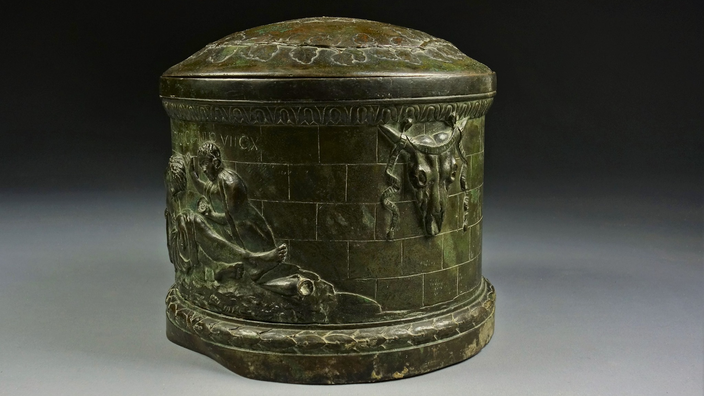This is a surprising acquisition for the Forum de Bavay.
Despite its assortment of antique motifs, from its beautiful bucrane to its figurative decoration through its ornamental friezes, this so-called Hirtius urn has only the name of the antique.
This is a false manifesto.
The height of the deception: the Roman numerals on the said ballot box would contain an error in their numbering.
This archaeological museum in Hauts-de-France has nevertheless decided to exhibit it.
Not in the midst of true Roman antiquities, nor in the fabulous treasure of Late Empire bronzes for which it is famous, but in a space dedicated to the history of this city and its region.
Read also: In Bavay, a major project to preserve the largest ancient forum discovered in France
For the Bavay museum, this object should add to the modern collections of the Ancient Forum, which devotes part of its galleries to the activity of local antique dealers in the 18th and 19th centuries. As precursors of contemporary archaeologists, these curious scholars were the first to rediscover - more or less skillfully - the ancient Roman city of Bagacum, now Bavay. One of the pioneers of this scholarly movement was Father Jean-Baptiste Lambiez, who in 1790 discovered the magnificent Bacchus tripod kept at the Archaeological Museum of Arkéos in Douai. Other antique dealers, alongside enlightened amateurs, however, were more interested in simply accumulating a collection of antique objects.To the point of being sometimes fooled by
"
archaeological mystifications"
.
Antique fake, but a true object of history
Hirtius' urn is precisely one of these mystifications.
In 1834, Hector Bochard, claimed to have discovered it near the Roman road connecting Reims to Bavay.
The object then passes to be the cinerary urn of consul Aulus Hirtius, a former lieutenant of Caesar who died in 43 BC.
AD in front of the troops of Marc Antoine, during the battle of Mutina (current Modena, in Italy).
Thus this precious artefact, originally so "noble", is the object of several sales before being lost sight of in 1869, a time when its fraudulent nature is no longer in doubt.
And with good reason, since Hector Bochard is recognized as a villainous merchant.
Detail of Hirtius' urn. Behind the wounded warrior is an astonishing putto (a winged child), an unusual figure for a bronze supposed to be from the 1st century BC to say the least. BC. Ancient Forum of Bavay, archaeological museum of the Department of the North
As the Bavay Forum indicates in a press release,
"Hector Bochard is known to be a follower of the dubious trade in modern fakes, the discovery of which he claimed in the town of Bavay in order to give them the luster of Antiquity"
. The north of France had at the time become one of the centers of circulation of these counterfeit antique objects. As unflattering as it is, this illicit network is also part of the history of Hauts-de-France, as the affair of the
“Amiens grotesques”
recalled some thirty years ago.
. Discovered in 1987 by amateur excavators, a hundred astonishing statuettes had aroused the perplexity of researchers before being recognized as fakes,made from scratch by their "discoverers".
Recently reappeared on the antiques market, the urn was purposely acquired in March by the Bavay Archaeological Museum for nearly 7,000 euros.
"If we bought this piece, it was to study it, compare it to other questionable pieces to identify whether they come from the same workshop, etc."
,
the director of the Antique Forum Véronique Beirnaert-Mary
told
20 Minutes
.
"Thus, we will be able to better understand archeology in Bavay in the 19th century"
. Perhaps the work of an Italian or Dutch forger, its inspection and serialization could better identify its precise origins, or even the workshop from which it comes. Enough to identify in the future other more credible fakes which would have escaped the vigilance of the conservatives… unless of course, thanks to an incredible twist, the urn turns out to be authentic!

